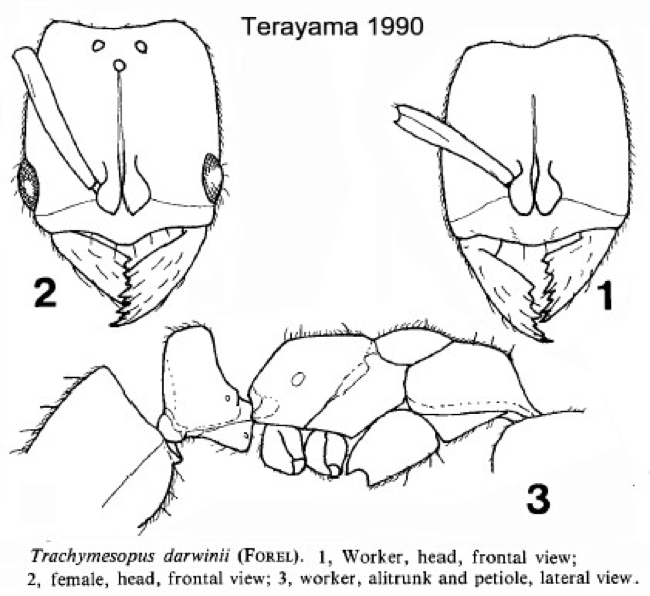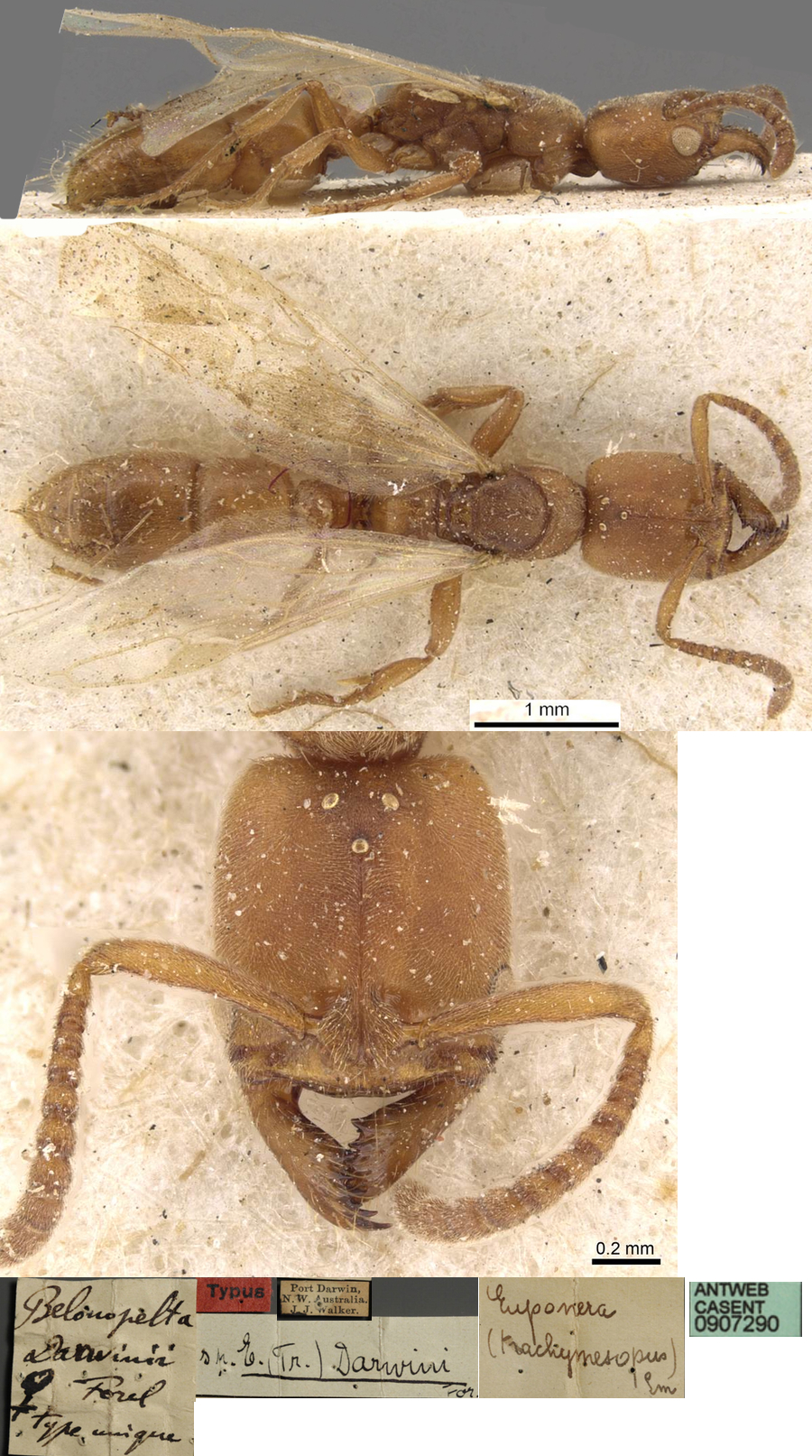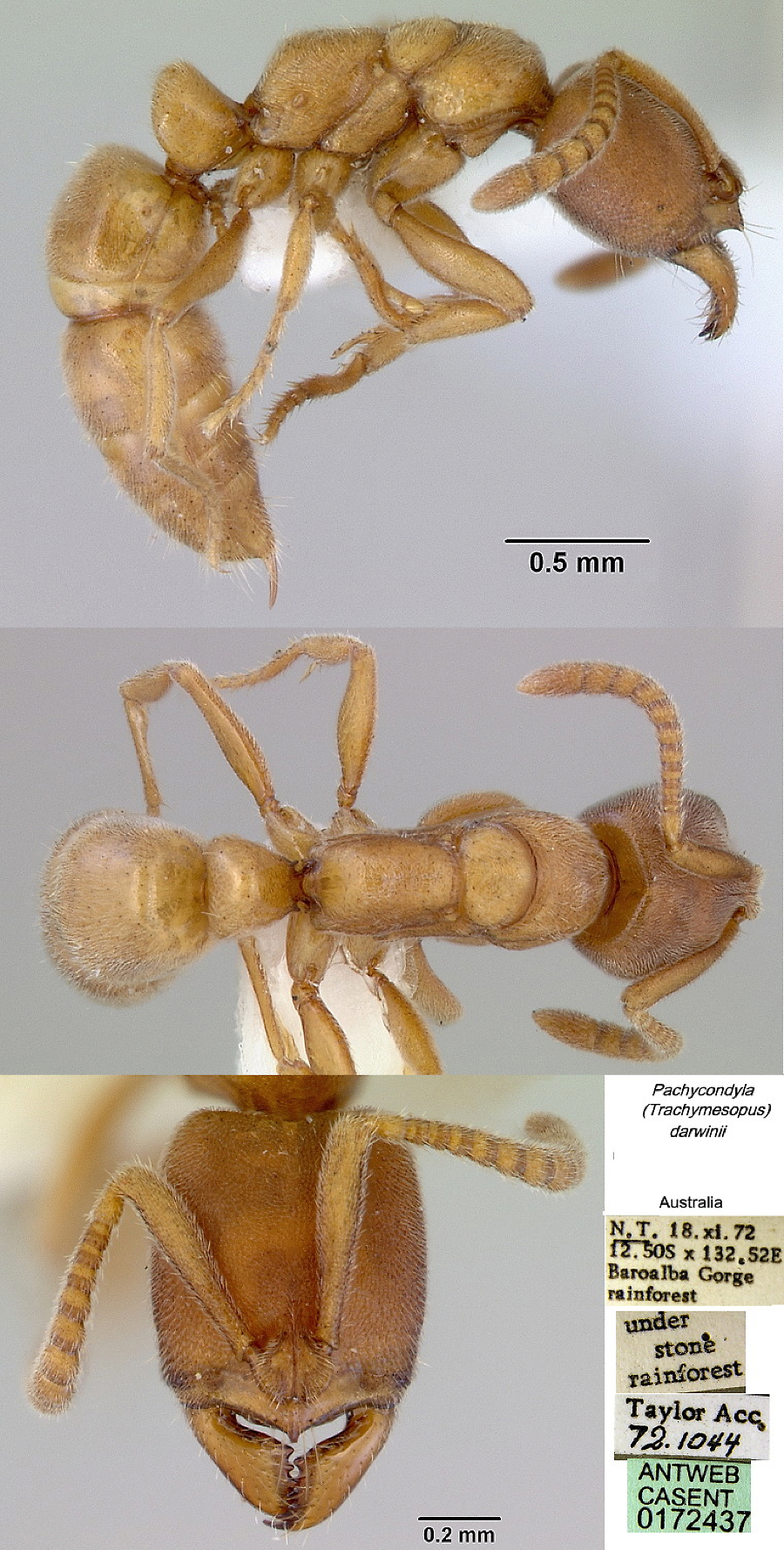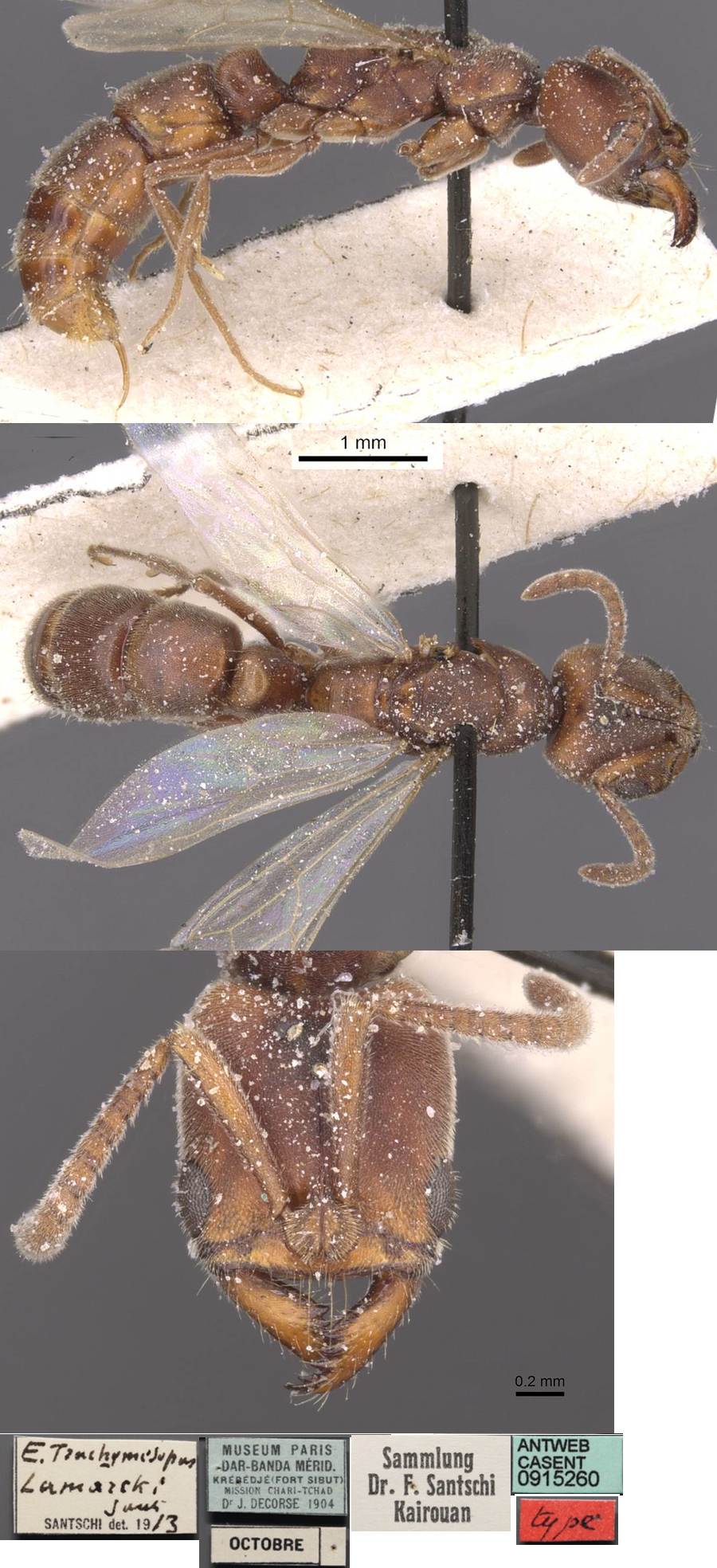|
Genus Parvaponera
defined by Schmidt & Shattuck (2014: 199) with P. darwinii as type species.
Diagnosis. Workers of Parvaponera
can be separated from other Ponerinae by the following combination of
characters: eyes small (2-4 facets) or absent, mandibles short, without
a basal pit or groove, propodeal spiracle generally elongate or
slit-like (oval or nearly circular in a few species), ventral apex of
the metatibia with one pectinate and one simple spur and subpetiolar
process triangular and with an anterior fenestra and/or a pair of
teeth. They are most likely to be confused with Centromyrmex, Hypoponera or Ponera. While both Centromyrmex and Parvaponera have reduced eyes, Parvaponera lacks pusher-setae on
the tibiae as found in Centromyrmex
(although they are present on the mesobasitarsus in some species of Parvaponera) and has a much more
complex subpetiolar process which possesses either an anterior fenestra
or posteroventral teeth, both of which are lacking in Centromyrmex. While superficially
similar to Hypoponera and Ponera, Parvaponera has a pair of spurs
present on the metatibia while only a single spur is present in these
genera.
|
Parvaponera darwinii (Forel)
  Type location Australia
(Belonopelta Darwinii, n. sp., Forel, 1893d: 460, queen;
Terayama, 1990:
897, worker; in Bolton, 1995: 304, as Pachycondyla
(Trachymesopus) darwinii; ) Darwin - see below Type location Australia
(Belonopelta Darwinii, n. sp., Forel, 1893d: 460, queen;
Terayama, 1990:
897, worker; in Bolton, 1995: 304, as Pachycondyla
(Trachymesopus) darwinii; ) Darwin - see below
junior synonyms
lamarki (Euponera
(Trachymesopus) Lamarki n. sp., Santschi,
1913c: 303, queen; synonymy by Brown, 1963: 6; - note he
actually wrote "all of these forms [medium small ferruginous-coloured
females] may well represent a single species) from Congo,
Southern Darbanda, Decorse, 1904 - see below
rufotestaceus (Cryptopone
rufotestaceus, Donisthorpe, 1943b: 197, queen) from India,
noted by Brown "as the same as the large variant, of T. darwinii hitherto known as T. lamarki"-
see http://www.antweb.org/specimenImages.do?code=casent0902505
subspecies
africana (Euponera
(Pseudoponera) Darwini Forel var. africana n. var., Forel, 1909b: 51, queen; Santschi,
1914b:
51, male) from Congo, Luki, A. Jullien - no images on Antweb
(June 2014)
indica
(Belonopelta darwinii Forel
var. indica nov. var., Emery,
1899f: 268, queen) from Burma - see http://www.antweb.org/specimenImages.do?code=casent0903940
madecassa
(Belonopelta Darwini For. var.
madecassa n. var.,
Emery, 1899f: 268, queen) from Madagascar - see http://www.antweb.org/specimenImages.do?code=casent0101691
all forms described
(see Bolton, 1995)  . .
|
Note: The
African forms seem almost certainly to be a different species. I
show what evidence is available at the bottom of this page but without
images of africana offer no
firm conclusions. I note that Schmidt & Shattuck write of species
occurring in Tropical Africa but provide no information other than "P. darwinii africana (Forel, 1909)
DRC (comb. nov.)" and do not list lamarki
anywhere in their review. The form rufotestaceous
also is not mentioned anywhere by them.
|
Forel's (1893d) description of the queen is at  . Forel's (1900d) description of indica
is at . Forel's (1900d) description of indica
is at  . Forel's (1909b)
description of africana is at . Forel's (1909b)
description of africana is at  . Santschi's (1913c)
description of lamarki is at . Santschi's (1913c)
description of lamarki is at  - Brown (1963: 6)
synonymizing this with darwinii described it as a large variant
(TL 5.6 mm). Donisthorpe's (1943b) description of rufotestaceus
is at - Brown (1963: 6)
synonymizing this with darwinii described it as a large variant
(TL 5.6 mm). Donisthorpe's (1943b) description of rufotestaceus
is at  . .
|
 Terayama (1990:
897) - see Terayama (1990:
897) - see  - described what he felt was the previously
undescribed worker. The photomontage at the bottom shows a worker
presented on www.Antweb.org that is from the type area around Darwin,
Australia. Generally that and the Terayama drawing are similar but the
Australian specimen clearly shows the prominent median tooth on the
anterior margin of the clypeus that was emphasised by Forel (1893d). - described what he felt was the previously
undescribed worker. The photomontage at the bottom shows a worker
presented on www.Antweb.org that is from the type area around Darwin,
Australia. Generally that and the Terayama drawing are similar but the
Australian specimen clearly shows the prominent median tooth on the
anterior margin of the clypeus that was emphasised by Forel (1893d).
|
 The
photomontage of the type queen is collated from http://www.antweb.org/specimen.do?name=casent0907290. The
photomontage of the type queen is collated from http://www.antweb.org/specimen.do?name=casent0907290.
|
 The
photomontage is collated from http://www.antweb.org/specimen.do?name=casent0172437.
It is labelled as P. darwini. Australia: Northern
Territory: Baroalba Gorge; 12°30'00"S 132°31'12"E Collection
Information: Collection codes: ANTC6642 Collected by: R.W.Taylor &
J.E.Feehan Habitat: rainforest Date: 18 Nov 1972 Method: under stone. The
photomontage is collated from http://www.antweb.org/specimen.do?name=casent0172437.
It is labelled as P. darwini. Australia: Northern
Territory: Baroalba Gorge; 12°30'00"S 132°31'12"E Collection
Information: Collection codes: ANTC6642 Collected by: R.W.Taylor &
J.E.Feehan Habitat: rainforest Date: 18 Nov 1972 Method: under stone.
|
Notes on African forms
The queen of africana, as described by Forel
(1909b), has - head almost as wide as long; petiole node less truncated
than the type, more rounded posteriorly, upper anterior border less
clear and, in profile not forming an slightly acuminate angle (seen in
the type, but as in indica). Rest as variety indica,
and even more so var. madecassa, which has a similar petiole
node, but not as rounded as africana. Specimen from Zaïre,
Luki, Lower Congo, by Dr. A. Jullien.
Santschi's lamarki queen has TL 6 mm; but
clypeus impressed in the centre between two rudiments of carinae which
reunite posteriorly. Propodeum dorsum longer than wide. More robust
than darwini Forel
Wheeler (1922) listed it (as variety africana)
from Nigeria (Lagos, F. Silvestri), Zaïre and Kenya.
Santschi (1930a: 54-55) lists lamarcki from Mali,
Koulouba (Andrieu, xii.1928, 1 queen) and Ivory Coast
(Dimbroko, Le Moult, 1 queen); he listed africana also from Mali,
Koulouba (Andrieu, vi.1928, 2 queens)
It seems quite possible that these all were actually Pachycondyla
(Trachymesopus) fossigera. That is generally similar, although
darker than the yellowish darwinii type form. It also is
distinctly larger TL ca 6 mm cf darwinii TL 4.3-4.9 mm,
and has a broader head CI 98-100, darwinii CI 92-93.
Alternatively, the distribution suggests that it is a
tramp species, moving aboard ship, and mostly known from the female
form only but that would not account for the records from well inland
in Mali.
|
 The
photomontage of the lamarki type queen is collated from http://www.antweb.org/specimen.do?name=casent0915260.
This is some 25% larger than the type form. The head is a
different shape and the scapes reaching the occiput rather than falling
well short. The
photomontage of the lamarki type queen is collated from http://www.antweb.org/specimen.do?name=casent0915260.
This is some 25% larger than the type form. The head is a
different shape and the scapes reaching the occiput rather than falling
well short.
|
|